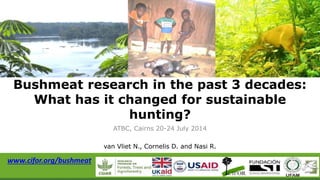
Bushmeat research in the past 3 decades: What has it changed for sustainable hunting?
- 1. ATBC, Cairns 20-24 July 2014 van Vliet N., Cornelis D. and Nasi R. Bushmeat research in the past 3 decades: What has it changed for sustainable hunting? www.cifor.org/bushmeat
- 2. Introduction Mammals Amphibians Reptiles Birds Bushmeat is defined by the CBD (2008) as any non-domesticated terrestrial mammals, birds, reptiles and amphibians harvested for food. Insects, crustaceans, grubs, molluscs and fish are excluded from this definition.
- 3. Introduction 4 million tons / year in the Congo Basin 1 million tons/ year in the Amazon BeefBushmeat • Europe produces 7,5 million tons /year of beef • Brazil (second world producer) produces 8,5 million tons /year of beef
- 4. Bushmeat as an evolving topic • Ecological issues • Socio-economic issues • Health issues • Cultural issues Transitions in disciplines, theoretical frameworks and management options tested in the field Future trends in bushmeat research
- 5. Transitions in disciplines and theoretical frameworks related to Bushmeat Ecological issues (1990-onwards)
- 8. Ecological issues (1990s-onwards) Simple biological models Robinson & Redford, 1991 Transitions in disciplines and theoretical frameworks related to Bushmeat
- 9. Ecological issues (1990s-onwards) Law enforcement and sensitization (Hyp: Hunting is criminal, unsafe and unsustainable) Department of Geography & Geology
- 10. "According to BIOLOGICAL MODELS, HUNTING IS UNSUSTAINABLE AND DUIKERS ARE BOUND TO BECOME EXTINCT, but DUIKERs don't know anything about BIOLOGICAL MODELS, so they ahead and SURVIVE anyway.” Nathalie van Vliet
- 11. Transitions in terms of the theoretical frameworks used for the analysis Ecological issues (1990s-onwards) “Long-term population monitoring programmes will be the most informative approach to provide baseline information against which any hunting effects and/or conservation interventions can be monitored” REV I EW A N D SY N TH ESI S Searching for sustainability: are assessments of wildlife harvests behind the times? Karen Z. Weinbaum,1 * Justin S. Brashares,1 Christopher D. Golden1,3 and Wayne M. Getz1,2 Abstract The unsustainable harvest of wildlife is a major threat to global biodiversity and to the millions of people who depend on wildlife for food and income. Past research has called attention to the fact that commonly used methods to evaluate the sustainability of wildlife hunting perform poorly, yet these methods remain in popular use today. Here, we conduct a systematic review of empirical sustainability assessments to quantify Ecology Letters, (2013) 16: 99–111 doi: 10.1111/ele.12008 REV I EW A N D SY N TH ESI S Searching for sustainability: a harvests behind the times? Karen Z. Weinbaum,1 * Justin S. Brashares,1 Christopher D. Golden1,3 and Wayne M. Getz1,2 Abstract The unsustainable harvest of wildlife is a major t who depend on wildlife for food and income. Pas used methods to evaluate the sustainability of wild popular use today. Here, we conduct a systematic the use of sustainability indicators in the scientifi Ecology Letters, (2013) 16: 99–111
- 12. Ecological issues (1990s-onwards) Socio-economic issues (2000 onwards) “There is a need to shift the bushmeat debate onto more positive terrain, recognizing the many benefits which the trade in wild meat offers the range state economies”. Transitions in disciplines and theoretical frameworks related to Bushmeat
- 13. Ecological issues (1990s onwards) Socio-economic issues (2000 onwards) Transitions in disciplines and theoretical frameworks related to Bushmeat Markets Food security and nutrition Local livelihoods Poverty and income
- 14. Department of Geography & Geology Ecological issues (1990s-onwards) Law enforcement and sensitization Socio-economic issues (2000 onwards) Alternatives of livelihood (Hyp: People will switch to other alternatives of income and food if those were made available)
- 15. Ecological issues (1990 s onwards) Socio economic issues (2000 onwards) Health issues (2005 onwards) Transitions in disciplines and theoretical frameworks related to Bushmeat
- 16. Ecological issues (1990s onwards) Socio economic issues (2000 onwards) Health issues (2005 onwards) Cultural aspects (2010 onwards) Transitions in disciplines and theoretical frameworks related to Bushmeat
- 17. Bushmeat in the international policy framework
- 18. Future trends in Bushmeat research Food security and health Cultural Identity Ecological foot print
- 19. Department of Geography & Geology Multifuntionality of hunting Sustainable hunting and trade?
- 20. Future trends in Bushmeat research Is sustainable hunting still possible?
- 21. Future trends in bushmeat research Resilience theory and socio- ecological systems Biological models Bio-economic models Spatially explicit models Multidisciplinary approaches: Economy Ecology Ethno biology Health …. Innovative techniques Camera trapping Genetics Telemetry Bio-chemical analysis Modeling tools ….
- 22. Pictures: Nathalie Van Vliet, Daniel Cornelis, Blanca Yague THANK YOU In Cairns FORESTS, WILDLIFE & NUTRITION
- 24. Innovative ways for conserving the ecosystem services provided by Bushmeat Should African governments pull bushmeat trade out the shadows in the Congo Basin? (Cornelis D.) Can alternative livelihoods projects reduce hunting pressure? Lessons from Central Africa for practitioners and donors (Coad L.) Health and economic valuation of the subsistence harvest of wildlife in Madagascar (Golden C.) Change in Game Harvest Composition, southeastern Cameroon: A Potential Indicator of Overhunting for Local People (Yasuoka H.) Towards Sustainable Bushmeat Procurement To Improve Food And Income Security In Amazonia (Pinedo Vasquez M.) Predicting hunting behavior among indigenous communities in Ecuador: insights from a bioeconomic model (de la Montaña E.) Participatory monitoring of the bushmeat trade in the amazonian triborder frontier (Colombia, Peru & Brazil) (Cruz D.) Economic value of bushmeat in the Amazon and poverty alliviation (Hernandes S.) Cultural Connections of Periurban Indigenous Communities to Tropical Forest through Bushmeat Networks in Leticia (Colombia) (Yagüe B.) Beyond protein intake: bushmeat as a source of micronutrients in the tri-frontier region (Brazil-Colombian-Peru) (Mori F.) Certifying bushmeat market chains: an option for sustainable hunting in Colombian Amazon ? (Quiceno M.P.)
